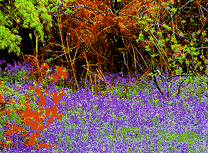
Chabana - Tea FlowersIn the tearoom a branch of red berried elder looks beautiful with a
single pale pink camelia. An evening primrose arranged with a stem of
thistle and a sprig of honeysuckle reminds us of the season and the
scenery of a wild field.
These flowers are delicate. Their bloom doesnít last, and for
this reason they are appreciated and valued. Chabana, as tea flowers are called, are not arranged for
decoration. They are an expression of heart and mind.
Rikyu, the famous tea master, once had a garden filled with
morning glories. The shogun Hideyoshi was invited to an early morning tea
just to view them, but when he arrived there were none to be seen anywhere.
Feeling disappointed he entered the tearoom and looked into the alcove.
There, placed in a bamboo vase, was one single flower shining with the
morning dew. Rikyu had cut down all the flowers, saving just this one for
the tea.
The flowers and grasses used for chabana are found growing wild,
yet many can be cultivated. The Urasenke Foundation in San Francisco grows
itís tea flowers on the roof, and many students plant native perennials in
their gardens. A few that may be familiar are the bellflower, the California
wild poppy, narcissus, pinks, bush clover, and star anise. Grasses such as bindeweed,
loosestrife, smartweed, and many others can be cultivated in your back yard.
Arrange tea flowers as though growing wild in a mountain field.
It is said that you should place them in a vase with one breath.
The vase should be chosen according to the season. In summer
use baskets and bamboo containers. They have a feeling of airiness and
coolness. In winter use porcelain, bronze, and unglazed
pottery.
Carefully choose an odd number of flowers and grasses. Each
flower should be a different color, shape, and have a different leaf
pattern. If you place a single camelia in a vase make sure it has an
odd number of leaves.
Wash and clean the leaves to remove any dirt, and recut the
stems under water. The water is immediately drawn into the flower and
revitalizes it.
First arrange the flowers lightly in your hands, and then
place them carefully in the vase. They should be free and natural. At the
opening of the vase the stems should be uncrowded and most of the leaves close
to the mouth should be removed. After arranging, spray cold water like a
mist of dew on the petals and leaves.
| 